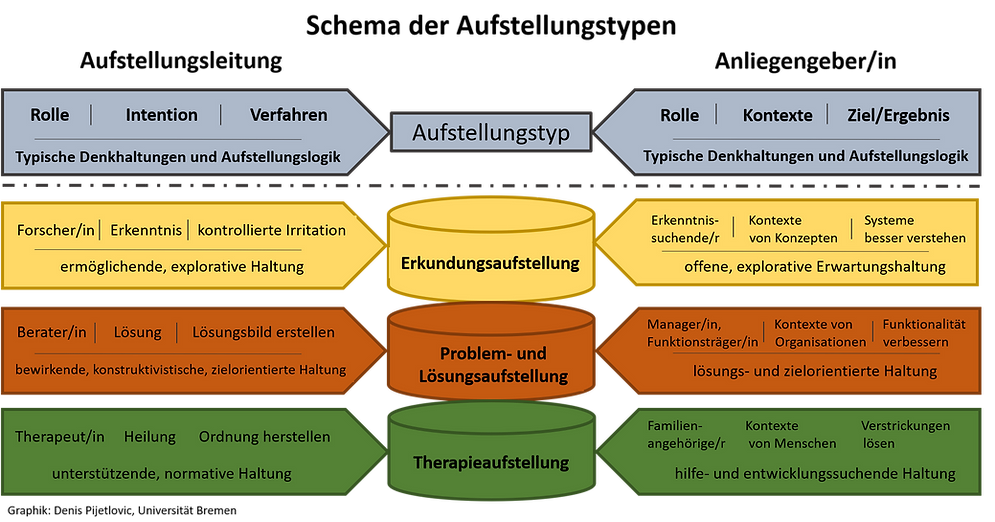Method
The number of people who have experienced a constellation or heard about it through stories is constantly increasing
This also makes it easier and easier to describe briefly what a constellation is. The method thrives on the fact that it visualizes a system in three dimensions, regardless of whether it is a family, team, organization or nation. This image in space alone often triggers great learning effects for those who know the system, because they suddenly have a whole in mind for which they otherwise only have inner and blurred images. Such an image is often created quickly, but the challenge of the method lies in the fact that the representatives for the system have information at their disposal at the moment they enter the image that they did not have before.
This phenomenon is usually called representative perception and accounts for the overall effect of a constellation. Experienced representatives, but also beginners, bring previously unnoticed or completely unknown information about the system into the room. So that the observers and those who raise concerns can deal constructively with the sometimes unexpected information, we strongly recommend that a constellation should only be carried out by proven leaders. Unexpected information through representative perception can also be disturbing for everyone involved. Solid theoretical knowledge and a lot of practical experience enable the constellation leaders, who are certified as professionals or master trainers according to our quality criteria, to deal with all situations that constellations can generate in a therapeutically cautious and/or advisory goal-oriented manner.
So far, even science has been unable to explain why this phenomenon of representative perception exists. Research is already taking place on this topic, to which our members are also contributing. Ultimately, however, we all learned through our work that lists generate very helpful information in order to be able to deal with complex issues in companies.
In his dissertation at Universität , Denis Pijetlovic designed the following scheme, which reflects the variety of constellations and the requirements of the method very well.

Development
The first expeditions to a foreign country – career changers as pioneers
The history of the organization constellation begins in 1995 in Kufstein (A) in the sense of pure trying out. Bert Hellinger was asked if he could come up with organizational topics for some interested people and friends. One of the participants in this seminar, for whom his own work system was set up, was Gunthard Weber, who made known the Family Constellation according to Bert Hellinger with his book Zweierlei Glück (1994). The pioneers in the organizational area were such potent and prudent people as Gunthard Weber (psychiatrist, systemic family therapist) and Brigitte Gross (psychotherapist and NLP trainer), who set the line and the level. In their excellent basic article (Weber, 1998), the two authors laid a 15-page basis that is still largely valid today, despite the rapid development. Today we call the procedure from these early days classic organizational constellation. In analogy to the members of the family, the members of an organizational unit or a team were set up and the dynamics between these people were worked on. It was soon recognized that this only partially represented an organization. Little by little, elements such as goals, customers, products etc. were added. Representational perception - astonishing enough for people - also worked for abstract elements.
The abstract form of access opens up new insights into the complex world of organization
Two other lateral entrants did and are doing groundbreaking groundwork: Matthias Varga von Kibéd, Professor of Logic, Philosophy and Theory of Science and Insa Sparrer, Psychologist and Psychotherapist. They systematically developed a comprehensive theory and grammar for what they called systemic structural constellations (Varga/Sparer, 2000; Sparrer, 2001, 2006). Rather abstract structure- and process-determining elements such as the problem, obstacle A, B, decision options (tetralemma) etc. were introduced; Possibilities of covert intervention and process work were found, which made it possible to work on sensitive issues in a public setting, outside and inside the company. Compared to the Family System, other, more complex systemic orders became recognizable. Varga v. Kibéd was the first to point out - following Erickson - to speak as much as possible in the language of the client (i.e. customer). All in all, this brought a decisive step closer to the reality of organizations. A climate keen to experiment was created across the board.
The system constellation as an integrated management and consulting tool
To the extent that systemically oriented organizational specialists (consultants, managers, specialists) have discovered the instrument for themselves, a new direction is developing. The system constellation is unspectacularly integrated as one of several tools in ongoing consulting or management processes. New constellation formats are being developed that are conceptually and linguistically linked to the respective professional field. This applies above all to the fields of OE/change management, strategy, vision, goals, marketing, advertising, market research, project management, HR management ua
In addition to the pioneers mentioned, many consultants and internal organizations were involved in the translation work into the field of organizations, such as T. Siefer, M. Wingenfeld, Grochowiak (2001), Horn/Brick (2001, 2003), C. Essen, JJ Stam, M. Blumenstein, A. Boutellier, Groth/Stey (2007), F. Assländer, Rosselet/Lingg/Senoner (2007), B. Knegendorf, B. Sachs-Schaffer, C. Regojo and many others published in the practical work in and with organizations have contributed to the development. From the German-speaking area, the method has spread to many countries worldwide.